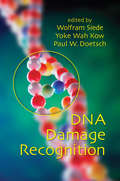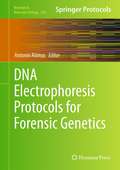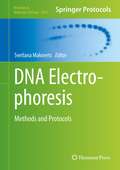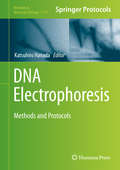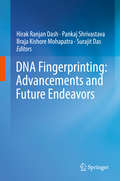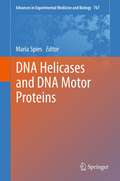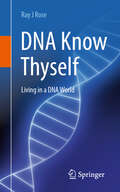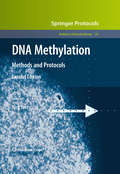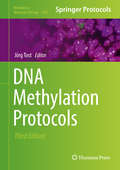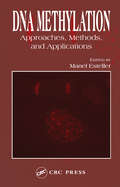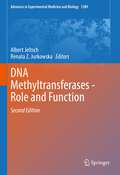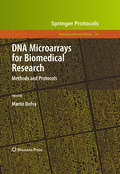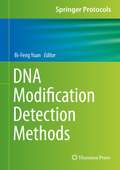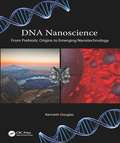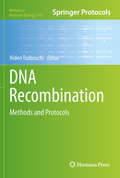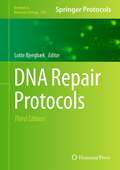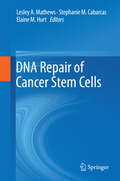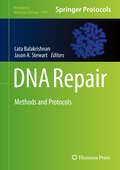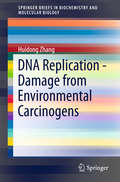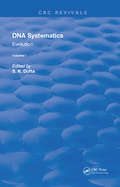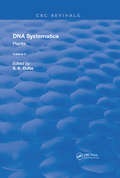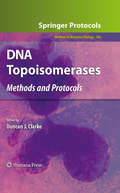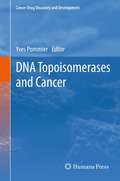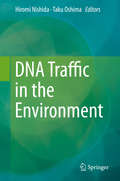- Table View
- List View
DNA Damage Detection In Situ, Ex Vivo, and In Vivo
by Vladimir V. DidenkoRecent advances in organic chemistry, fluorescent microscopy, and materials science have created an entirely new range of techniques and probes for imaging DNA damage in molecular and cellular biology. In DNA Damage Detection In Situ, Ex Vivo, and In Vivo: Methods and Protocols, expert researchers explore the latest advances in the area, covering both recent and established techniques to detect and quantify DNA damage at scales ranging from subcellular to the level of a whole live organism. Chapters present all major assays used in molecular and cellular biology for the labeling of DNA damage in situ, ex vivo, and in vivo. Composed in the highly successful Methods in Molecular BiologyTM series format, each chapter contains a brief introduction, step-by-step methods, a list of necessary materials, and a Notes section which shares tips on troubleshooting and avoiding known pitfalls. Comprehensive and current, DNA Damage Detection In Situ, Ex Vivo, and In Vivo: Methods and Protocols is an essential handbook for novice and experienced researchers in a variety of fields, including molecular and cellular biology, experimental and clinical pathology, toxicology, radiobiology, oncology, embryology, experimental pharmacology, drug design, and environmental science.
DNA Damage Recognition
by Wolfram Siede Yoke Wah Kow Paul W. DoetschStands as the most comprehensive guide to the subject-covering every essential topic related to DNA damage identification and repair.Covering a wide array of topics from bacteria to human cells, this book summarizes recent developments in DNA damage repair and recognition while providing timely reviews on the molecular mechanisms employe
DNA Electrophoresis Protocols for Forensic Genetics
by Antonio AlonsoForensic DNA profiling procedures are mainly based on high resolution and high throughput capillary electrophoresis separation and detection systems of PCR amplicons obtained from DNA genomic markers with different inheritance patterns. In DNA Electrophoresis Protocols for Forensic Genetics, expert researchers in the field detail many of the protocols and methods which are now commonly used to perform forensic DNA profiling. It includes protocols for profiling of autosomal STRs, Y-STRs, X-STRs, autosomal SNPs, INDELS, Y-SNPs, mtDNA-SNPs, and mtDNA hypervariable regions HV1 and HV2 . Protocols for molecular identification of non-human species and mRNA profiling for body fluid identification are also included. Written in the highly successful Methods in Molecular BiologyTM series format, chapters include introductions to their respective topics, lists of the necessary materials and reagents, step-by-step, readily reproducible laboratory protocols, and key tips on troubleshooting and avoiding known pitfalls.
DNA Electrophoresis: Methods and Protocols
by Svetlana MakovetsIn DNA Electrophoresis: Methods and Protocols, expert researchers in the field detail many of the methods which are now commonly used to study DNA using electrophoresis as the major approach. A powerful tool that allows separating DNA molecules according to their size and shape, this volume includes methods and techniques such as 2-dimentional gel electrophoresis as the major approach. These include methods and techniques such as 2-dimentional gel electrophoresis, DNA electrophoresis under conditions in which DNA molecules are completely or partially denatured during the runs, Pulse Field Gel Electrophoresis, electrophoresis coupled to fluorescence in situ hybridization, as well as protein-DNA interactions studied using electrophoreses. Written in the highly successful Methods in Molecular Biology series format, chapters include introductions to their respective topics, lists of the necessary materials and reagents, step-by-step, readily reproducible laboratory protocols, and key tips on troubleshooting and avoiding known pitfalls. Authoritative and practical, DNA Electrophoresis: Methods and Protocols aids scientists in continuing to study DNA dynamics both in live cells and in test tubes.
DNA Electrophoresis: Methods and Protocols (Methods in Molecular Biology #2119)
by Katsuhiro HanadaThis volume explores the latest techniques used by researchers to study DNA electrophoresis, with focus on various species including bacteria, yeasts, and mammalian cells. The chapters in this book cover topics such as two-dimensional gel electrophoresis; DNA replication; pulsed-field gel electrophoresis; ChIP; and post-labeling/PAGE method for detection of DNA adducts. Written in the highly successful Methods in Molecular Biology series format, chapters include introductions to their respective topics, lists of the necessary materials and reagents, step-by-step, readily reproducible laboratory protocols, and tips on troubleshooting and avoiding known pitfalls.Cutting-edge and authoritative, DNA Electrophoresis: Methods and Protocols is a valuable resource for any researchers looking to learn more about this developing field.
DNA Fingerprinting: Advancements and Future Endeavors
by Surajit Das Hirak Ranjan Dash Pankaj Shrivastava Braja Kishore MohapatraThis book describes the basics and various applications of DNA fingerprinting, including in actual case studies. The book is divided in four modules; Module 1: Basics of DNA Fingerprinting, Module 2: Applications of DNA Fingerprinting, Module 3: DNA Fingerprinting: Case Studies, and Module 4: Future of DNA Fingerprinting. Each module consists of 4 to 5 chapters, written by reputed researchers, academics and forensic scientists from around the globe. The respective chapters cover e.g. related fields, the tools and techniques used, various genotyping kits, real-world case studies, ancient DNA and wild life forensics, molecular diagnosis of human diseases, legal aspects, microbial forensics and the economics of the DNA fingerprinting technique. The book offers a practical guide for professionals, graduate and post-graduate students in the fields of Forensic Science, Medicine, Genetics, Anthropology, Microbiology, and Zoology. It also serves as a useful reference resource, summarizing major technological advances in the field of DNA fingerprinting, the problems faced in this field of science and possible new solutions to these problems. Presently, DNA fingerprinting is utilized in solving the majority of criminal cases; as such, the book is also helpful for investigating agencies, as it includes representative case studies.
DNA Helicases and DNA Motor Proteins (Advances in Experimental Medicine and Biology #767)
by Maria SpiesIn recent years, a number of groundbreaking structural and mechanistic studies deepened our understanding of helicase mechanisms and established new approaches for their analyses. Many fundamental mechanistic questions ranging from the mechanism of force generation, mechanochemical coupling to distinct mechanisms by which the same enzyme translocates on DNA removing obstacles, unwinds DNA and/or remodels nucleoprotein complexes, however, remain to be answered. It is even less understood how the helicase motors are incorporated into a wide range of genome maintenance and repair machines. The field has reached a stage when the studies of molecular mechanisms and basic biology of helicases can and shall be integrated with the studies of development, cancer and longevity. The objective of this book is to provide the first systematic overview of structure, function and regulation of DNA helicases and related molecular motors. By integrating the knowledge obtained through the diverse technical approaches ranging from single-molecule biophysics to cellular and molecular biological studies the editors aim to provide a unified view on how helicases function in the cell, are regulated in response to different cellular stresses and are integrated into large macromolecular assemblies to form a complex and adaptive living system.
DNA Know Thyself: Living in a DNA World
by Ray J RoseThe book provides a concise, integrated view of DNA biology and biotechnology in various aspects, such as human health, food production, environmental sustainability, and industry development. It covers the evolution of DNA, genes, cancer, aging biology, and plant gene technology. The chapters delve into the evolution of DNA, cells, genes, and regulation and its influence on cancer, aging, and development. The book emphasizes modern DNA biotechnology, including plant gene technology, gene therapy, and synthetic biology, and highlights the relevance of DNA knowledge in addressing global challenges. It focuses on providing a contemporary understanding and the background of DNA biology, making it suitable for science and medicine programs or as an introduction to specialized DNA/biotechnology areas. The book targets academicians, researchers, and clinicians in related fields. It is also a valuable resource for anyone interested in understanding DNA and its applications in various fields.
DNA Methylation
by Jörg TostOver the past few years, DNA methylation technologies and our knowledge of DNA methylation patterns have been advancing at a breathtaking pace. Due to this fact, DNA Methylation: Methods and Protocols, Second Edition completely revises, updates, and expands upon the popular first edition with the most current novel techniques, easier to use and more refined by the tested experience of leading experts. This revision reflects contemporary study of the subject: the analysis of gene-specific DNA methylation patterns has been complemented by genome-wide approaches, and epigenomics takes a central place. Written in the highly successful Methods in Molecular BiologyTM series format, the chapters in this volume present brief introductions to the topics, lists of the necessary materials and reagents, step-by-step, readily reproducible laboratory protocols, and notes which highlight tips on troubleshooting and avoiding known pitfalls. Comprehensive and cutting-edge, DNA Methylation: Methods and Protocols, Second Edition is the perfect resource for scientists who wish to further our understanding of the molecular processes that determine the genomic DNA methylation landscape and for those who aim to identify and implement DNA methylation-based biomarkers for clinical and diagnostic applications.
DNA Methylation Protocols (Methods in Molecular Biology #1708)
by Jörg TostThis third edition volume expands on the previous editions by providing a comprehensive update on the available technologies required to successfully perform DNA methylation analysis. The different technologies discussed in this book analyze the global DNA methylation contents, comprehensive analyses using various NGS based methods for genome-wide DNA methylation analysis, along with precise quantification of DNA methylation levels on single CpG positions. The chapters in this book are divided into 7 parts: an introduction to the field along with tips on study design and data analysis; global DNA methylation levels; genome-wide DNA methylation analysis; highly multiplexed target regions; locus-specific DNA methylation analysis; DNA methylation analysis of specific biological samples; and hydroxymethylation. Written in the highly successful Methods in Molecular Biology series format, chapters include introductions to their respective topics, lists of the necessary materials and reagents, step-by-step, readily reproducible laboratory protocols, and tips on troubleshooting and avoiding known pitfalls.Cutting-edge and thorough, DNA Methylation Protocols, Third Edition is a valuable resource for postdoctoral investigators and research scientists who work with different aspects of genetics, and cellular and molecular biology, as well as clinicians who are involved in diagnostics or treatment of diseases with epigenetic components.
DNA Methylation: Approaches, Methods, and Applications
by Manel EstellerDNA Methylation: Approaches, Methods and Applications describes the relation DNA methylation has to gene silencing in disease, and explores its promising role in treating cancer. Written by leaders in the field, this exceptional compilation of articles outlines the best techniques to use when addressing questions concerning the cytosine methylation
DNA Methyltransferases - Role and Function (Advances in Experimental Medicine and Biology #1389)
by Albert Jeltsch Renata Z. JurkowskaThis 2nd edition of the book on DNA methyltransferases has been comprehensively updated to reflect many novel research findings regarding the structure, function, and technology of these enzymes that have emerged over the past 6 years.Like the previous edition, this 2nd edition explains the biochemical properties of DNA methyltransferases, describing their structures, mechanisms and biological roles in bacteria, humans and plants. It also discusses the biological processes of reading DNA methylation and the mechanisms of DNA demethylation. This volume highlights the newest findings on DNA methyltransferase inhibitors and their use in cancer therapy as well as the latest epigenome editing systems based on these enzymes. Overall, this 2nd edition comprehensively summarizes the current state of research in the field of DNA methylation and DNA methyltransferase and is essential reading for early career and advanced researchers in this exciting field.
DNA Microarrays for Biomedical Research
by Martin DufvaDNA microarray technology has revolutionized research in the past decade. Initially an application for mRNA expression studies, the technology now has spread to other applications such as comparative genomic hybridization, SNP and mutation analysis. In DNA Microarrays for Biomedical Research: Methods and Protocols, experts explore these now commonly used applications, addressing probe design strategies, fabrication issues and providing practical examples of detailed methods for generation of high quality DNA microarray data. Chapters incorporate information on some of the largest providers of microarray, including Affymetrix, Ilumina and Agilent, and their use on a variety of applications. Composed in the highly successful Methods in Molecular Biology series format, each chapter contains a brief introduction, step-by-step methods, a list of necessary materials, and a Notes section which shares tips on troubleshooting and avoiding known pitfalls. Authoritative and highly practical, DNA Microarrays for Biomedical Research: Methods and Protocols presents a variety of protocols which can be easily reproduced, allowing researchers to gain surprising insight into the complex world of DNA microarray technology.
DNA Modification Detection Methods (Springer Protocols Handbooks)
by Bi-Feng YuanUnderstanding the functional roles of DNA modifications relies on the accurate detection, quantification, and mapping of DNA modifications. Methods for deciphering DNA modifications have substantially improved over the last several years, which greatly revolutionize the field of DNA modifications. In addition to DNA cytosine methylation (5-methylcytosine, 5mC), the best-characterized epigenetic modification, many new modifications have been discovered to present in DNA in recent years. This book provides a comprehensive overview of available techniques and methods together with detailed step-by-step protocols for experimental procedures required to successfully perform analysis on various types of DNA modifications, including 5mC, 5-hydroxymethylcytosine (5hmC), 5-formylcytosine (5fC), 5-carboxycytosine (5caC), 5-hydroxymethyluracil (5hmU), 5-formyluracil (5fU), N6-methyladenine (6mA), β-D-glucosyl-5-hydroxymethyluracil (base J) and 8-oxo-7,8-dihydroguanine (OG). This laboratory manual is a valuable source for biochemists and molecular biologists from different fields who wish to investigate DNA modifications.
DNA Nanoscience: From Prebiotic Origins to Emerging Nanotechnology
by Kenneth DouglasDNA Nanoscience: From Prebiotic Origins to Emerging Nanotechnology melds two tales of DNA. One is a look at the first 35 years of DNA nanotechnology to better appreciate what lies ahead in this emerging field. The other story looks back 4 billion years to the possible origins of DNA which are shrouded in mystery. The book is divided into three parts comprised of 15 chapters and two Brief Interludes. Part I includes subjects underpinning the book such as a primer on DNA, the broader discipline of nanoscience, and experimental tools used by the principals in the narrative. Part II examines the field of structural DNA nanotechnology, founded by biochemist/crystallographer Nadrian Seeman, that uses DNA as a construction material for nanoscale structures and devices, rather than as a genetic material. Part III looks at the work of physicists Noel Clark and Tommaso Bellini who found that short DNA (nanoDNA) forms liquid crystals that act as a structural gatekeeper, orchestrating a series of self-assembly processes using nanoDNA. This led to an explanation of the polymeric structure of DNA and of how life may have emerged from the prebiotic clutter.
DNA Recombination
by Hideo TsubouchiHomologous recombination is important in various aspects of DNA metabolism, including damage repair, replication, telomere maintenance, and meiosis, and yeast genetics has successfully provided a framework for the mechanism of homologous recombination. Divided into four convenient sections, DNA Recombination: Methods and Protocols covers recent techniques that best utilize the advantages of the yeast system, prescribing to the belief that yeast will keep serving as a great model organism to study homologous recombination. Chapters have also been included for such exceptions as the group of genes involved in recombination that are found solely in higher eukaryotes, such as BRCA2. And looking forward, a necessary step in the direction of understanding the homologous recombination process is to isolate the machine and let it work in a test tube. Understanding the design by studying the appearance and behavior of the machinery as a single molecule will be an important milestone toward understanding the mechanism of action of the machinery. Techniques covering these topics have also been included. Written in the successful Methods in Molecular BiologyTM series format, chapters include introductions to their respective topics, lists of the necessary materials and reagents, step-by-step, readily reproducible protocols, and notes on troubleshooting and avoiding known pitfalls. Authoritative and easily accessible, DNA Recombination: Methods and Protocols serves as an ideal guide to scientists of all backgrounds with its well-honed methodologies and strives to bring the reader to the next level of understanding regarding this vital subject.
DNA Repair Protocols
by Lotte BjergbækCurrent knowledge of the mechanisms that regulate DNA repair has grown significantly over the past years with technology advances such as RNA interference, advanced proteomics and microscopy as well as high throughput screens. The third edition of DNA Repair Protocols covers various aspects of the eukaryotic response to genomic insult including recent advanced protocols as well as standard techniques used in the field of DNA repair. Both mammalian and non-mammalian model organisms are covered in the book, and many of the techniques can be applied with only minor modifications to other systems than the one described. Written in the highly successful Methods in Molecular Biology? series format, the chapters include the kind of detailed description and implementation advice that is crucial for getting optimal results in the laboratory. Thorough and intuitive, DNA Repair Protocols, Third Edition provides expert guidance for DNA repair, recombination, and replication.
DNA Repair of Cancer Stem Cells
by Stephanie M Cabarcas Lesley A Mathews Elain HurtThe existence of 'cancer stem cells' (CSCs) has been a topic of heated debate for the last few years within the field of cancer biology. Their continuous characterization in a variety of solid tumors has lead to an abundance of evidence supporting their existence. CSCs are believed to be responsible for resistance against conventional treatment regimes of chemotherapy and radiation, ultimately, leading to metastasis and patient demise. To help aid clinicians, pharmaceutical companies and academic labs investigating how to better kill these highly aggressive cells we have summarized the DNA repair mechanism(s) and their role in the maintenance and regulation of both normal and cancer stem cells. Our book represents a comprehensive investigation into the highly effective DNA repair mechanisms of CSCs and what we need to understand in order to develop more advanced therapies to eradicate them from patients. Currently, there are no other published works entirely on DNA repair and Cancer Stem Cells. In addition, our book provides a comprehensive overview of CSC isolation and characterization from a variety of solid tumor types.
DNA Repair: Methods and Protocols (Methods in Molecular Biology #1999)
by Lata Balakrishnan Jason A. StewartThe volume outlines techniques used to study the primary mechanisms of important DNA repair pathways. The chapters in this book are organized into five sections, each discussing a specific aspect of repair biology. Part I reviews the role of post-translational modifications of HDR, and DNA damage caused by defective telomere replication. Part II describes methods to detect and measure DNA breaks and proteins involved in DNA damage response. Part III talks about methods designed to measure DNA repair efficiency and characterize factors involved in the repair process. Part IV discusses various in vitro assays used to purify recombinant proteins that are used to study DNA repair enzyme mechanisms. Lastly, Part V focuses on methods to study the damage arising during DNA replication. Written in the highly successful Methods in Molecular Biology series format, chapters include introductions to their respective topics, lists of the necessary materials and reagents, step-by-step, readily reproducible laboratory protocols, and tips on troubleshooting and avoiding known pitfalls.Cutting-edge and authoritative, DNA Repair: Methods and Protocols is an essential resource for novice and experienced researchers, and provides easily adaptable techniques to help them advance in their specific protein or repair pathway of interest.
DNA Replication - Damage from Environmental Carcinogens
by Huidong ZhangThis book reviews the main concepts concerning DNA damage due to environmental carcinogens, the effects of DNA damage on DNA replication using a single DNA polymerase or DNA replisome, and the effects of carcinogens on various cell activities. It also introduces the detailed protocols for bypassing DNA damage. As we know, various environmental carcinogens are produced as a result of industry, agriculture, chemical engineering and vehicle exhaust in our daily life. It has been reported that the environmental carcinogens can be connected to tumors and cancer, directly threatening human health. In this regard, DNA replication is highly susceptible to damage. This book provides graduate students and researchers with an overview of the effects of environmental carcinogens on DNA replication and biological activities in cells. It offers important information for research in the areas of biochemistry, cell biology, medicine, toxicology and public health.
DNA Systematics: Evolution (Routledge Revivals #1)
by S. K. DuttaFirst Published in 1986, these volumes offer a full, comprehensive guide to the structure of DNA systems and their biochemical application. Carefully compiled and filled with a vast repertoire of notes, diagrams, and references this book serves as a useful reference for Genealogy and other practitioners in their respective fields.
DNA Systematics: Plants (Routledge Revivals #2)
by S. K. DuttaFirst Published in 1986, these volumes offer a full, comprehensive guide to the structure of DNA systems and their biochemical application. Carefully compiled and filled with a vast repertoire of notes, diagrams, and references this book serves as a useful reference for Genealogy and other practitioners in their respective fields.
DNA Topoisomerases
by Duncan J. ClarkeDue to their importance to cell biology, DNA topology-altering enzymes, collectively DNA topoisomerases and gyrases, have been studied thoroughly from a biochemical perspective, yet the expansion of research at the molecular and cellular levels continues to show a great deal of promise. In DNA Topoisomerases: Methods and Protocols, experts in the field present a compendium of protocols that extends into the new areas of research that have been recently uncovered in order to elucidate the methodology needed to study topoisomerases in the molecular and cellular context. The volume examines subjects such as the analysis of DNA topologies and the interaction of topoisomerases with DNA as tools to measure topoisomerase functions, the binding of topoisomerases to specific sites in the genomes of eukaryotes, including origins of DNA replication, as well as exploration of perturbed topoisomerase function. As a volume in the highly successful Methods in Molecular BiologyTM series, chapters include introductions to their respective topics, lists of the necessary materials and reagents, step-by-step, laboratory protocols, and notes on trouble-shooting and avoiding known pitfalls. Cutting-edge and easy-to-use, DNA Topoisomerases: Methods and Protocols provides key content which reflects an expanded understanding of the functions of these essential enzymes in the hope of inspiring researchers to further important discoveries in this dynamic field.
DNA Topoisomerases and Cancer
by Yves PommierDNA topoisomerases represent an essential family of DNA processing enzymes and a large number of topoisomerase inhibitors are used clinically for the treatment of various human cancers. Novels drugs are in clinical development both against type I and type II topoisomerases. The book will include basic biochemical and structural reviews for the cancer-relevant topoisomerases. It will describe how topoisomerase dysfunctions can damage the genome and increase the risk of cancers, and the involvement of topoisomerases in programmed cell death. The book will also present the various topoisomerase inhibitors in clinical use and development and their molecular and cellular mechanisms of action.
DNA Traffic in the Environment
by Hiromi Nishida Taku OshimaThis book comprehensively discusses our current understanding of the role and biological mechanisms of horizontal transfer of genetic elements in the environment, which has been important in the evolution of prokaryotes (archaea and bacteria). Horizontal transfer of genetic elements generates variations of prokaryotes and their genomes. Comparative studies of genomes revealed that it frequently occurred during archaeal and bacterial evolution. The book introduces a variety of studies related to horizontal gene transfer, gene silencing, plasmids, phages, transposons, and the emergence of microbes that degrade man-made xenobiotics and have antimicrobial resistance. Written by leading researchers in DNA traffic, the book is a valuable guide to horizontal transfer for both young scientists and experts in the field.

